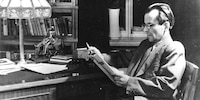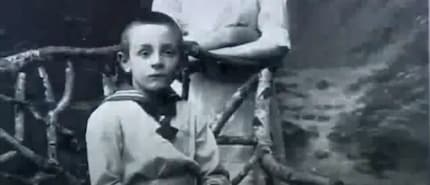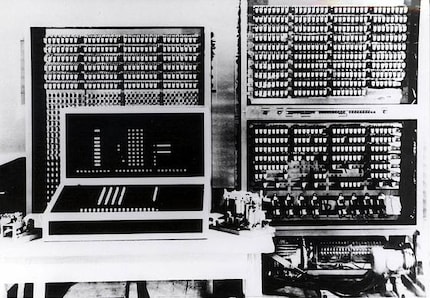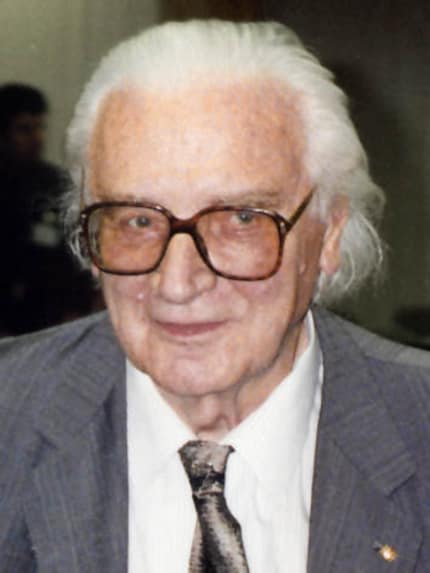
Background information
Sergey Lebedev and the first Soviet computer
by Kevin Hofer

Who invented it? The Germans! More specifically, Konrad Zuse. This dreamer, visionary and inventor developed the first fully automatic universal calculator in history, during the Second World War.
We hear a roar and a hiss. The floor shakes. The tools on the table vibrate. The year is 1943. Berlin is in a state of emergency. The Allies launch air strikes almost every night. Those who can, take refuge in the bunkers. But not Konrad Zuse. This gifted tinkerer does what he does best: he invents calculating machines, even when the bombs are falling.
Konrad Zuse was born on 22 June 1910 in Berlin. His father Emil was a civil servant and his mother Maria a housewife. His talent for artistic design became apparent at an early age. A dreamer, Konrad loved to paint and play. He would like to become an artist. His parents were very tolerant, supporting and encouraging their son. He's very interested in technical works, never letting go of his metal construction kit.

After graduating from secondary school in 1928, Konrad Zuse enrolled at Berlin's Technical University, where he studied mechanical engineering. Seeing no future in the political climate of Germany at the time, he abandoned art. He realised that his creative spirit was quickly hampered by the straitjacket of university. He changed faculties several times, eventually studying civil engineering.
After graduating in 1934, he worked for a short time for the Henschel-Flugzeug-Werke company in Berlin, where his main task was calculating, from morning to night, which he described as inhumane. He resigned in 1935. Towards the end of his studies, Konrad Zuse was already thinking about building a fully automatic calculating machine. He wanted to make this dream come true.
As he doesn't have the money for a workshop, he shares his vision with his parents. They want to support their son by making their showroom available to him. And it doesn't stop there; the father, already retired, goes back to work to finance his son's dream. The sister and Kurt Pannke, a calculator manufacturer, also support Konrad Suze.
From 1936 to 1938, with the help of friends in his parents' living room, he cobbled together a calculating machine that was supposed to work in binary form. He incorporated a memory, an arithmetic unit and a control unit, three elements that also distinguish today's modern computers. In 1938, the completed Z1 became the world's first programme-controlled calculating machine. However, this error-prone machine consisted of thousands of metal plates - painstakingly cut with a scroll saw by Konrad Zuse and his friends - which jammed again and again during operation. Konrad Zuse does not admit defeat.

From 1938 to 1939, Konrad Zuse designed the Z2. Instead of metal plates, he used telephone relays for the computing unit, which he obtained from an armoury where electromechanical relays that could no longer switch telephone links landed. He had to adapt each of the 800 relays to his Z2. The experiment was a success: Konrad Zuse was convinced of its reliability. As he was still using metal plates for the memory, he began building the Z3, which was supposed to work entirely with relay technology.
The Z3 consisted of around 600 relays in the calculator and 1400 in the memory. On 12 May 1941, the moment had come: Konrad Zuse presented the Z3. Those present were enthusiastic, but none other than Konrad Zuse himself understood the significance of his invention. The Z3 is the world's first digital, binary, programmable and storable computer system.

The Second World War is raging. Konrad Zuse comes to the attention of the National Socialists. He is funded by several institutions. Konrad Zuse's position on National Socialism is unclear. He accepts their support and does not distance himself from it.
Z1 and Z3 were destroyed by Allied bombing raids. In the 1980s, Konrad Zuse recreated the Z1 from memorabilia. The model, still on display at the Deutsches Technikmuseum in Berlin, is further proof of his genius. During the hard years of the war, he met and married Gisela. He continued to work on calculating machines. He was unable to complete the Z4 in Berlin. In 1945, he fled with Gisela, who was pregnant, and the Z4. Like many other refugees from Berlin, the family ended up in Göttingen. It was there that he received an offer from the National Socialists to take his computer to the Dora-Mittelbau concentration camp, where the prisoners were working on missiles. However, the atrocities of the concentration camp frightened Konrad Zuse, who fled with his family to the Alps.
At Hinterstein, in the Allgäu, Konrad Zuse, to hide the Z4 from the Allies, dismantles it into several pieces. His son Horst is born in the village. To make ends meet, Konrad Zuse made wood engravings, which he exchanged for food from the farmers. Despite the adversity, his calculating machines never let him down. Meanwhile, he was writing his Plankalkül, the first superior programming language. All modern programming languages are based on the concepts of Plankalkül.
At this time, Howard Aiken was considered, in the United States, to be the inventor of the modern computer, several years after Konrad Zuse's success in commissioning his Z3. However, with the machine destroyed and his 1941 patent application pending, Konrad Zuse cannot prove that he was the first.
In 1949, Konrad Zuse dared a fresh start. In the newly proclaimed Federal Republic of Germany, he founded Zuse K.G., a company that started with three people. First he finished his Z4 and lent it to ETH Zurich. He attracted the attention of other companies. The company grew rapidly. In a television report from 1958, Hessischer Rundfunk focuses on the start-up. In the years that followed, Konrad Zuse built one of the main centres of the European computer industry. By the mid-1960s, Zuse K.G. employed over 1,000 people. Business affairs and paperwork were taking up more and more of his time. His business skills were not as well developed as those of the inventor, and he made some bad decisions. The company, which was encountering more and more problems, was then sold to Siemens in 1967.
But that wasn't all: in 1967, his patent application for the Z3 was rejected. The reason? Lack of inventive step. This decision followed years of litigation with Triumph Werke Nürnberg, supported by IBM Germany. The companies are trying to prove, using historical documents, that other inventors anticipated Konrad Zuse's concept. The strategy is working. For Konrad Zuse, 26 years of anxious waiting and litigation ended in huge disappointment. All the more so since his vision of a fully automatic calculating machine became a reality with the Z3. Thanks to him, computers perform the most monotonous of computing tasks.

Despite this blow, Konrad Zuse is not giving up and is still trying to prove a point with his Z3. At the same time, he rededicated himself to his first love: painting. It was only with time that he received recognition for his work. In 1999, he became, posthumously, an honorary member of the Palo Alto Museum of the History of the Computer for his work.
He followed the development of computers throughout his life. He also became a whistleblower and advocated data protection and control. He goes on to describe his career as follows:
« Daydreaming potato, rambling student, thwarted artist, bricklayer, computer tinkerer, failed entrepreneur, professor without honorarium, carnival humorist, misunderstood benefactor, overworked inventor, enlightened philosopher.»
Konrad Zuse died in December 1995 at the age of 85. He left behind one last piece of advice on what to do if computers became too powerful:
« If computers become too powerful, unplug the power cord.»
From big data to big brother, Cyborgs to Sci-Fi. All aspects of technology and society fascinate me.
Interesting facts about products, behind-the-scenes looks at manufacturers and deep-dives on interesting people.
Show all